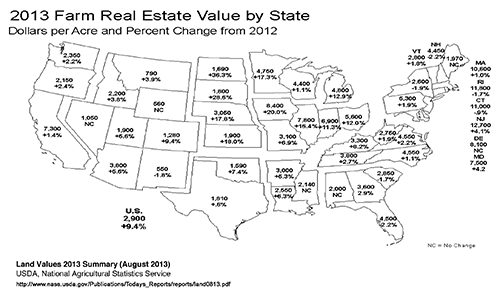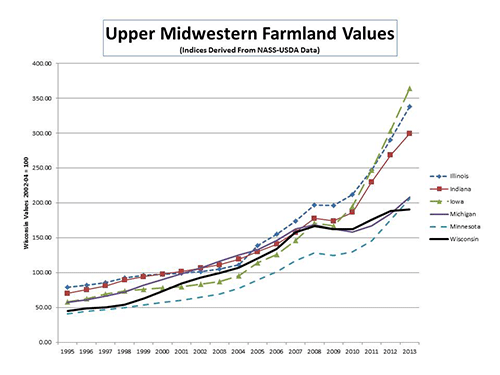
Wisconsin's More Modest Growth in Farmland Values Reflects the Economics of Cows vs. Corn, says UW AG Economist
When it comes to Midwest farmland prices, Wisconsin is looking sort of like a tortoise in a field of hares. That's because farmers in America's Dairyland often reinvest their profits in cows rather than land, says University of Wisconsin-Madison agricultural economist Bruce Jones.
Two reports published in August both showed that states adjacent to Wisconsin recorded double-digit percentage increases in farm real estate values since a year ago, while Wisconsin's were up 1.1 percent according to a USDA survey and by about 7 percent according to the Federal Reserve Bank of Chicago.
It's not a surprise, and it's not worrisome, says Jones. It simply reflects differences between the economics of producing milk and grain.

"We're capitalizing our returns into cows as well as land," he says. "In Illinois and Iowa, if you're going to increase your returns you need to farm more acres. In Wisconsin you could increase returns by adding acres, but you can also invest in cows."
It also reflects an inverse relationship in profitability between the two enterprises, he adds. "High grain prices equal high feed prices, and those are offsetting dairy returns," he says.
The USDA's National Agricultural Statistics Service (NASS) survey found that Wisconsin's average farmland value was $4,400 in 2013, compared to $4,350 last year. Increases in the five states touching Wisconsin ranged from 11.3 percent in Indiana to 20 percent in Iowa. The average U.S. farmland price climbed 9.4 percent.

According to the Chicago Fed survey, the increase in prices in Wisconsin's neighbors ranged from 17 percent in Illinois to 21 percent in Indiana.
Results from the two surveys don't align perfectly because the two are directed at different groups of people, Jones explains. NASS conducts a comprehensive survey of producers while the Chicago Fed asks farm lenders about changes in the price of "good" farmland. The two also cover somewhat different territories. The Fed's survey covers the Seventh Federal Reserve District, which excludes some central and northern counties in Wisconsin (it also excludes Minnesota).
Over the past half-century, the rise in value in Wisconsin farmland has been remarkably consistent, Jones says.
"Going back to 1960, if you take out the period of 1974 to 1987, when prices spiked for five years and then dropped, Wisconsin land prices have trended up at an average rate of 7.1 percent," he says. "Actual prices today are very close to that trend line. Whereas since about 2009, actual prices in Illinois and Iowa have risen at a dramatically greater rate as compared to their 50-year trend."
9.9.2013